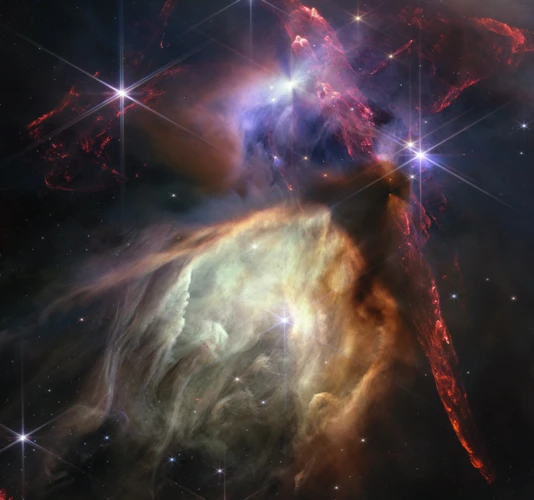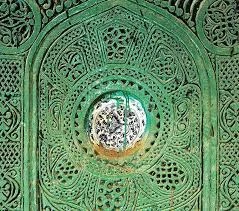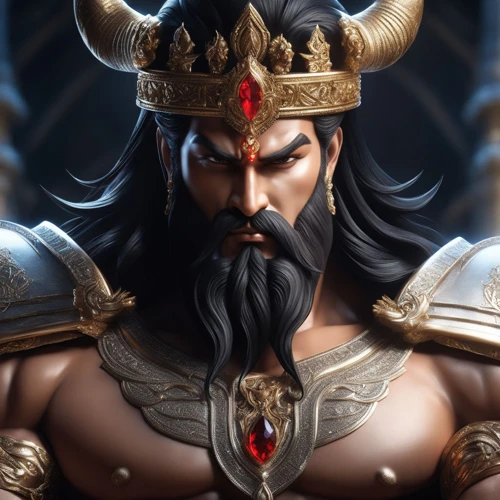The story of Ramayana in Hindu mythology is a captivating tale of epic heroism, bravery, and devotion. It transports us to a world filled with gods, demons, and extraordinary beings where the forces of good and evil clash in a battle of cosmic proportions. The journey of Rama, the protagonist of the story, is one that captivates both the mind and the soul. From his birth to his exile, from his quest to rescue his beloved wife to the ultimate triumph of good over evil, the Ramayana is a timeless saga that continues to inspire and awe people across generations. Let us delve into the enchanting world of Ramayana, where valor and righteousness are put to the test against insurmountable odds.
Contents
- The Birth of Rama
- Rama’s Exile and Quest
- Ravana, the Mighty Demon King
- The Epic Battle
- Triumph of Good over Evil
- Legacy and Cultural Significance
- Conclusion
-
Frequently Asked Questions
- 1. What is the significance of Rama’s birth in Hindu mythology?
- 2. Who were Rama’s parents?
- 3. What were the celestial signs and prophecies surrounding Rama’s birth?
- 4. What does Rama’s birth symbolize in Hindu mythology?
- 5. How is Rama’s birth celebrated in Hindu culture?
- 6. Is Rama considered an incarnation of a Hindu deity?
- 7. How does Rama’s birth affect the events of the Ramayana?
- 8. What qualities and virtues is Rama known for?
- 9. Is Rama worshipped as a deity in Hinduism?
- 10. What life lessons can be learned from Rama’s birth and journey?
- References
-
Frequently Asked Questions
- 1. What is the significance of Ramayana in Hindu mythology?
- 2. Who is the main hero of the Ramayana?
- 3. How was Lord Rama born?
- 4. What led to Rama’s exile?
- 5. What was Rama’s quest during his exile?
- 6. Who is Ravana and why is he considered a mighty demon king?
- 7. How did the epic battle between Rama and Ravana unfold?
- 8. What was the ultimate outcome of the battle?
- 9. What is the legacy and cultural significance of Ramayana?
- 10. Why is Ramayana still revered and celebrated today?
- References
- Read More
The Birth of Rama

In the captivating story of the Ramayana, the birth of Rama marks the beginning of an extraordinary saga. Rama, the seventh incarnation of Lord Vishnu, was born to King Dasharatha and Queen Kausalya in the kingdom of Ayodhya. The birth of Rama was no ordinary event. It was accompanied by celestial auspicious signs and divine prophecies, foretelling the arrival of a great hero who would rid the world of evil. The gods themselves showered blessings upon his birth, recognizing his future role in restoring righteousness and upholding dharma. Rama’s birth is celebrated with great joy and fervor to this day, during the festival of Rama Navami. His birth not only signifies the beginning of his epic journey, but also the divine intervention that sets the stage for the triumph of good over evil.
Rama’s birth is intertwined with fascinating elements of Hindu mythology, symbolizing the divine intervention that shapes the destiny of mortals. The significance of his birth lies not only in his role as an epic hero, but also in the symbolism associated with his divine lineage. As the seventh incarnation of Lord Vishnu, Rama embodies the righteous and virtuous qualities revered in Hinduism. His birth reminds us of the eternal struggle between good and evil, and the relentless pursuit of righteousness in the face of adversity.
It is believed that Rama’s birth took place on the ninth day of the Hindu lunar month of Chaitra, during the spring season. This auspicious occasion is celebrated by devotees with fasting, prayers, and the recitation of hymns and scriptures. The birth of Rama is a reminder of the power of divine intervention and the extraordinary potential that lies within each individual to overcome challenges and fulfill their purpose in life.
The story of Rama’s birth is not only a mythological tale but also holds deep philosophical meaning. It teaches us about the inherent nature of duality in the world and the eternal battle between good and evil that exists within and around us. Rama’s birth signifies the eternal presence of righteousness and the cosmic balance that must be maintained for harmony to prevail.
As we delve deeper into the epic heroism of the Ramayana, we witness how the events following Rama’s birth unfold, shaping his destiny and setting the stage for the ultimate triumph of good over evil. The birth of Rama is a testament to the power of divinity and the inherent heroism that lies within each of us.
Rama’s Exile and Quest

Rama’s exile and quest form a pivotal part of the epic heroism in the Ramayana. After the celestial marriage of Rama and his beloved wife Sita, a chain of events led to Rama’s exile from the kingdom of Ayodhya. Obliged by his father’s promise to his scheming stepmother, Queen Kaikeyi, Rama embraced a life of hardship and selflessness in the forest. Accompanied by his loyal brother Lakshmana and devoted wife Sita, Rama embarked on a journey filled with trials and tribulations. During their exile, they encountered numerous sages, divine beings, and formidable demons, each presenting unique challenges that tested their character and determination. The exile period also saw the abduction of Sita by the mighty demon king Ravana, which would later ignite Rama’s unwavering resolve to rescue her and uphold dharma. The quest to find Sita led Rama to form alliances with an army of monkeys, most notably Hanuman, who played a crucial role in their search. This phase of the Ramayana showcases Rama’s unparalleled heroism, unyielding commitment to righteousness, and unwavering love for his wife, laying the foundation for the epic battle that would follow. Through Rama’s exile and quest, we witness the relentless pursuit of truth and justice, serving as a timeless inspiration for generations to come.
Rama’s Exile
Rama’s exile is a pivotal moment in the epic tale of Ramayana, where the hero’s path takes an unexpected turn. After Rama’s father, King Dasharatha, is compelled to fulfill a promise made to his second wife, Kaikeyi, Rama is forced to leave Ayodhya and spend fourteen years in exile. The news of his exile shakes the kingdom to its core, as Rama was beloved by all for his virtuous character and rightful claim to the throne.
During his exile, Rama demonstrates unwavering loyalty, obedience, and respect towards his father’s decision. He accepts his fate without resentment, highlighting his exceptional humility and devotion. Accompanied by his faithful wife, Sita, and devoted younger brother, Lakshmana, Rama embarks on a journey fraught with challenges and tests of character.
The exile period takes Rama through enchanting forests, sacred rivers, and mystical hermitages. Along the way, he encounters sages, divine beings, and demons, each leaving an indelible mark on his heroic journey. It is during this time that Rama’s strength, courage, and righteousness shine brightly as he selflessly protects the innocent and upholds the principles of dharma.
One of the most iconic episodes during Rama’s exile is his encounter with Surpanakha, the demoness and sister of the formidable demon king, Ravana. Surpanakha, enamored by Rama’s charm, attempts to win his affection. However, upon seeing Rama’s unwavering commitment to Sita, she becomes enraged and attacks Sita in a fit of jealousy. Lakshmana swiftly intervenes and disfigures Surpanakha, which sets in motion a series of events that lead to the epic battle between Rama and Ravana.
Throughout his exile, Rama’s character is tested in various ways. He demonstrates immense patience, compassion, and forgiveness, even in the face of adversity. His unwavering devotion to his moral values and commitment to duty make him a true hero in every sense of the word.
The period of Rama’s exile serves not only as a test for the hero, but also as a profound lesson in resilience, adaptability, and the power of staying true to one’s principles. Rama’s exile teaches us that even in times of great hardship and injustice, one must remain steadfast in upholding righteousness and remain true to their purpose.
As we journey alongside Rama through his exile, we bear witness to his unwavering heroism, unwavering faith, and his unyielding commitment to his values. His exile becomes a transformative phase in the epic, shaping him into a mighty warrior and a beacon of righteousness. It sets the stage for the ultimate quest that lies ahead and the ultimate triumph of good over evil.
Throughout the epic of Ramayana, the theme of heroism continues to resonate, as Rama’s exile exemplifies the strength of character, resilience, and unwavering determination that defines an epic hero.
Rama’s Quest
Rama’s Quest takes center stage in the epic narrative of the Ramayana, as he embarks on a perilous journey to rescue his beloved wife, Sita, from the clutches of the mighty demon king, Ravana. Driven by his unwavering love and duty, Rama, accompanied by his loyal brother Lakshmana and an army of vanaras (monkey warriors), traverses through treacherous forests, formidable mountains, and vast oceans in search of Sita.
The quest for Sita is not merely a physical undertaking but also a spiritual and moral odyssey for Rama. It tests his character, valor, and unwavering devotion to righteousness. Along his arduous journey, Rama encounters numerous challenges and overcomes formidable foes, displaying extraordinary courage and wisdom.
One of the most iconic episodes in Rama’s quest is his alliance with Hanuman, the mighty monkey god who becomes his devoted ally. Hanuman’s unwavering loyalty, remarkable strength, and unparalleled intelligence become instrumental in the success of Rama’s quest. In fact, Hanuman’s devotion towards Rama is so profound that he is considered the epitome of devotion (bhakti) in Hindu mythology.
Rama’s quest also offers profound life lessons that resonate with people from all walks of life. His relentless pursuit of truth, justice, and righteousness serves as a guiding light, inspiring individuals to stay committed to their principles even in the face of adversity. Rama’s unwavering determination and adherence to dharma (righteousness) make him an emblematic hero who serves as an embodiment of ideal virtues.
The quest for Sita also unveils the true nature of evil, as personified by Ravana. The demon king’s abduction of Sita represents the forces of darkness and unrighteousness that need to be confronted and ultimately defeated. Rama’s quest not only becomes a battle to rescue his wife but also a battle between good and evil, where the triumph of good is inevitable.
Throughout his quest, Rama encounters various divine beings, sages, and mystical creatures who offer their guidance and support. Their presence adds depth to the narrative, showcasing the interconnectedness between gods and mortals. Each encounter highlights Rama’s embodiment of righteousness and his ability to inspire unwavering devotion and loyalty in those around him.
As Rama’s quest progresses, it becomes a test of his character and his ability to make difficult decisions that uphold dharma. The challenges he faces, whether it be battling demons or overcoming personal doubts, allow him to grow and evolve as a hero. The trials and tribulations of Rama’s quest serve as a reminder that the path to righteousness is not always easy, but it is a journey worth embarking upon.
Ultimately, Rama’s quest in the Ramayana serves as a profound exploration of love, duty, sacrifice, and the triumph of good over evil. It is a testament to the indomitable spirit of heroism and the unwavering commitment to upholding righteousness. The lessons learned from Rama’s quest continue to inspire and shape the moral fabric of Hindu mythology and have a ripple effect in the lives of those who immerse themselves in this timeless epic.
Ravana, the Mighty Demon King

Ravana, the mighty Demon King, is a pivotal character in the epic tale of the Ramayana. Known for his immense power and unparalleled knowledge of the dark arts, Ravana was the ruler of Lanka and a formidable adversary to Rama. Described as a ten-headed demon with extraordinary physical strength, Ravana’s story is a fascinating exploration of the complexities of good and evil.
Born to the sage Vishrava and the demon princess Kaikesi, Ravana was a highly intelligent and ambitious being from the outset. He performed intense penance and pleased Lord Brahma, who granted him a boon that made him virtually invincible. Armed with his newfound powers, Ravana embarked on a conquest to dominate the world and prove his supremacy.
Ravana’s character is not solely defined by his malevolence. He was also an accomplished scholar, musician, and a devotee of Lord Shiva. However, his arrogance and unchecked ego ultimately led to his downfall. Ravana’s infatuation with Sita, Rama’s wife, drove him to abduct her and ignite the epic battle between him and Rama.
Ravana’s portrayal in the Ramayana offers a profound exploration of the human psyche and the struggles between virtue and vice. Despite his demonic nature, Ravana is depicted as a complex character with redeeming qualities. His unmatched might and intelligence coexist with his flaws, reminding us of the delicate balance between light and darkness within each of us.
The epic battle between Ravana and Rama showcases the clash between good and evil, righteousness and greed. Ravana’s prowess in combat is legendary, as he single-handedly defeated numerous deities and celestial beings. His ten heads symbolize his immense knowledge and ability to strategize with precision. However, his arrogance and disregard for ethical boundaries eventually paved the way for his downfall.
The story of Ravana serves as a cautionary tale, highlighting the consequences of unchecked power and the importance of humility. His defeat at the hands of Rama signifies the ultimate triumph of good over evil. It reminds us that no matter how formidable the forces of darkness may seem, righteousness and virtue will always prevail in the end.
The character of Ravana in the Ramayana embodies the duality of human nature and the eternal struggle between right and wrong. He serves as a reminder that even the mightiest of beings are not immune to the consequences of their actions. Ravana’s tale teaches us the importance of self-reflection, humility, and the pursuit of righteousness in order to overcome our own inner demons.
As we delve deeper into the epic heroism of the Ramayana, the character of Ravana stands as a testament to the complexity of human nature and the eternal battle between good and evil that exists within us all.
The Epic Battle

The epic battle in the Ramayana is a climactic and pivotal moment in the tale of heroism and valor. After Ravana, the mighty demon king, abducts Sita, Rama’s beloved wife, Rama embarks on a treacherous journey to save her and bring her back to Ayodhya. The battle between Rama and Ravana becomes an emblematic clash between good and evil, where divine weapons and extraordinary powers are unleashed.
Rama, aided by his loyal brother Lakshmana and an army of monkeys led by Hanuman, reaches the kingdom of Lanka, where Ravana has held Sita captive. The battlefield becomes a battleground showcasing the immense power and prowess of both Rama and Ravana. It is a clash not only of physical strength but also of inner resolve and righteousness.
Rama’s bow, the divine weapon called the ‘Sharanga,’ holds great significance in this epic battle. The bow represents Rama’s formidable strength and his unyielding devotion to righteousness. With the Sharanga in hand, Rama unleashes a barrage of arrows, each imbued with divine power, striking fear into the hearts of Ravana’s army.
Ravana, on the other hand, possesses his own arsenal of supernatural weapons, including the invincible “Brahmastra.” This weapon, granted to Ravana by Lord Brahma, showcases his immense power and arrogance. The battle between Rama and Ravana becomes a clash of gods and demons, where each combatant channels their divine essence to gain the upper hand.
The battlefield is adorned with extraordinary displays of courage and valor. Rama’s unwavering determination and righteousness fuel his every move, while Ravana’s arrogance and thirst for power blind him to the inevitable consequences of his actions. The clash between the two titans becomes a symbol of the eternal struggle between good and evil.
Amidst the chaos and destruction, the heroic feats of Rama and his allies shine bright. The monkey army, with their incredible strength and agility, relentlessly fight alongside Rama, while Hanuman’s unwavering loyalty and ability to assume immense sizes prove to be instrumental in the battle. The ferocity and intensity of the combat exceed all expectations, as gods and demons clash, shaking the very foundations of the earth.
The epic battle reaches its climax when Rama, with the help of a powerful arrow, pierces through Ravana’s heart, finally vanquishing the mighty demon king. The triumph of good over evil is celebrated, and Rama’s heroism is etched into the annals of history.
The epic battle in the Ramayana serves as a significant turning point in the story, showcasing the indomitable spirit of heroism and the dedication to righteousness. It symbolizes the eternal struggle that exists within every individual, where one must overcome their inner demons and confront the darkness that threatens to engulf the world. The battle teaches us the value of courage, resilience, and the unwavering commitment to upholding truth and justice.
As the dust settles and the echoes of the epic battle fade away, the triumph of good over evil stands as a testament to the power of righteousness and heroism. The legacy of Rama’s epic battle inspires countless generations, reminding us of the eternal fight between light and darkness, and the ultimate victory that awaits those who choose the path of righteousness.
Triumph of Good over Evil

The Ramayana depicts the epic battle between Rama, the embodiment of righteousness, and Ravana, the mighty demon king. The triumph of good over evil is at the heart of this epic narrative. Rama, aided by an army of loyal allies, including the valiant Hanuman, confronts Ravana to save his beloved wife, Sita, who was abducted by the demon king.
The battle between Rama and Ravana is not merely a physical confrontation, but a clash of ideologies and moral values. Ravana, with his immense power and knowledge, symbolizes ego, arrogance, and unrighteousness. On the other hand, Rama, guided by dharma and moral principles, represents virtue, humility, and compassion. The battle becomes a cosmic struggle, with the gods in the heavens and the demons on the earth watching the outcome with bated breath.
Rama’s unwavering devotion to righteousness and his selflessness in the face of adversity ignite a spark of hope in the hearts of all those who witness the epic battle. With his divine weapons and the support of his loyal allies, Rama engages in fierce combat with Ravana, displaying his superior strength and skill. The battle rages on for days, with both sides demonstrating remarkable valor and strategic prowess.
However, it is Rama’s unwavering faith in dharma and his righteousness that ultimately leads to the triumph of good over evil. Ravana, consumed by his own ego and arrogance, underestimates Rama’s prowess and his adherence to moral principles. In a climactic duel, Rama inflicts a fatal blow, bringing an end to Ravana’s reign of terror. The victory is not only a victory for Rama, but a triumph for righteousness and justice.
The triumph of good over evil in the Ramayana extends beyond the physical battle between Rama and Ravana. It symbolizes the eternal struggle between light and darkness, virtue and vice, and the choices individuals make in their own lives. Through the epic battle, the Ramayana teaches the importance of upholding moral values and the consequences of succumbing to the temptations of power and ego.
The triumph of good over evil in the Ramayana serves as a beacon of hope and inspiration for individuals in their own personal journeys. It reminds us that, no matter the challenges we face, righteousness and virtue will eventually prevail. It encourages us to stand firm in the face of adversity, to fight for what is just, and to remain steadfast in our pursuit of truth.
As we reflect on the triumph of good over evil in the Ramayana, we are reminded of the profound moral lessons embedded in this epic tale. It teaches us about the power of righteousness, the consequences of our actions, and the eternal quest for truth and justice. The Ramayana serves as a timeless reminder that, despite the trials and tribulations we may face, the triumph of good over evil is not only possible but inevitable.
Legacy and Cultural Significance

The legacy of Ramayana holds immense cultural significance in Hindu mythology and has left an indelible mark on society. The timeless tale of heroism and righteousness has not only captivated the hearts and minds of people across generations but has also shaped the cultural fabric of India and beyond. Let us explore the profound legacy and cultural significance of the Ramayana.
1. Cultural Integration: The Ramayana has played a pivotal role in promoting cultural integration. It has transcended regional and linguistic boundaries, becoming a cherished part of the collective consciousness of diverse communities. From the northern plains of India to the southern tip, the story of Rama has been celebrated through various art forms, literature, music, dance, and theater, enriching the cultural heritage of the land.
2. Moral and Ethical Values: The Ramayana serves as a moral compass, imparting invaluable life lessons and ethical values. It teaches the importance of upholding righteousness (dharma), honoring family ties, fulfilling responsibilities, and resisting temptations. The characters in the epic, such as Rama, Sita, Laksmana, and Hanuman, serve as role models, embodying virtues like truth, courage, loyalty, and devotion.
3. Religious Significance: Ramayana holds great religious significance for Hindus. It strengthens the devotion and faith of the believers in Lord Rama and his divine qualities. Devotees draw inspiration from the epic to deepen their spiritual connection and seek guidance for navigating through the challenges of life. The life lessons taught in the Ramayana provide a roadmap for leading a righteous and virtuous life.
4. Folklore and Oral Traditions: The Ramayana has been passed down through generations, becoming a part of the rich oral tradition and folklore of different regions. These stories and retellings, accompanied by music and recitation, have kept the epic alive in the hearts of the people. The Ramayana continues to be performed in various forms, such as Ramlila (religious theatrical performances), puppet shows, and storytelling, keeping the tradition alive and engaging new audiences.
5. Literary and Artistic Influence: The Ramayana has inspired countless poets, writers, and artists across centuries. Its influence can be seen in ancient Sanskrit literature, medieval poetry, and contemporary works. The epic has served as a catalyst for artistic expression, influencing sculpture, painting, dance, and literature. The characters and scenes from the Ramayana have been depicted in various art forms, leaving an indelible mark on the artistic heritage of the country.
6. Social Relevance: The Ramayana continues to be relevant to contemporary society, addressing issues such as gender dynamics, relationships, moral dilemmas, and the balance between personal and societal obligations. It prompts introspection and encourages individuals to reflect on their actions and choices, fostering personal growth and social harmony.
The cultural significance and legacy of the Ramayana are profound and enduring. It continues to be a source of inspiration and guidance for millions, transcending time and borders. Its teachings and values continue to shape our understanding of heroism, morality, and the eternal battle between good and evil. The Ramayana stands as a testament to the power of storytelling, reminding us of the universality of human experiences and the enduring wisdom embedded in ancient myths.
Conclusion

In conclusion, the epic heroism of the Ramayana in Hindu mythology continues to captivate and inspire people from all walks of life. The birth of Rama sets the stage for a gripping narrative of valor, righteousness, and the eternal struggle between good and evil. From his humble beginnings to his triumph over the mighty demon king Ravana, Rama’s journey teaches us important lessons about the power of devotion, loyalty, and the unwavering pursuit of dharma.
The Ramayana is not just a story, but a profound reflection of the human experience. It reminds us that heroism lies not only in physical strength and prowess, but also in moral integrity and the ability to make sacrifices for the greater good. Rama’s exile and quest symbolize the rigors and challenges of life, where one must navigate through trials and tribulations to ultimately fulfill their purpose.
The epic battle between Rama and Ravana showcases the clash between virtue and vice, light and darkness. It highlights the consequences of succumbing to temptation and the crucial role of righteousness in overcoming evil. Rama’s unwavering commitment to his purpose, his loyalty towards his allies, and his unwavering devotion to his wife Sita serve as shining examples of bravery, honor, and love.
The triumph of good over evil in the Ramayana reinforces the belief in the inherent power of righteousness. It serves as a constant reminder that no matter how daunting the obstacles may be, righteousness will always prevail in the end. The story emphasizes the importance of upholding dharma and the consequences of deviating from it.
The legacy and cultural significance of the Ramayana are far-reaching. It has been passed down through generations, shaping the values and beliefs of millions. The characters, teachings, and moral lessons of this epic continue to provide guidance and inspiration in navigating the complexities of life.
In a world filled with darkness and moral ambiguity, the heroism of Rama offers a beacon of hope and the promise of righteousness. The Ramayana reminds us that each one of us has the potential to be a hero in our own lives, to face challenges with courage, and to uphold the values of truth, love, and righteousness.
As we reflect on the extraordinary heroism of the Ramayana, we are reminded of the timeless wisdom and universal truths it imparts. The journey of Rama and the triumph of good over evil continue to resonate with audiences, transcending time, culture, and boundaries. The epic heroism of the Ramayana serves as a testament to the enduring power of mythology and its ability to inspire and transform lives.
Frequently Asked Questions

1. What is the significance of Rama’s birth in Hindu mythology?
Rama’s birth signifies the divine intervention and the arrival of a heroic figure who would combat evil and restore righteousness in the world.
2. Who were Rama’s parents?
Rama was born to King Dasharatha and Queen Kausalya of Ayodhya, an ancient kingdom in Hindu mythology.
3. What were the celestial signs and prophecies surrounding Rama’s birth?
Rama’s birth was accompanied by celestial signs like auspicious planetary alignments, divine voices, and blessings from the gods, indicating the significance of his arrival.
4. What does Rama’s birth symbolize in Hindu mythology?
Rama’s birth symbolizes the eternal struggle between good and evil, the triumph of righteousness, and the importance of upholding dharma (righteousness) in the face of adversity.
5. How is Rama’s birth celebrated in Hindu culture?
Rama’s birth is celebrated during the festival of Rama Navami with fasting, prayers, religious discourses, and the recitation of hymns and scriptures.
6. Is Rama considered an incarnation of a Hindu deity?
Yes, Rama is believed to be the seventh incarnation of Lord Vishnu, a principal deity in Hinduism.
7. How does Rama’s birth affect the events of the Ramayana?
Rama’s birth sets in motion a series of events that lead to his exile, the quest to rescue his wife Sita, and the epic battle against the demon king Ravana.
8. What qualities and virtues is Rama known for?
Rama is revered for his unwavering devotion, righteousness, valor, humility, and adherence to his duties as a prince and later as a king.
9. Is Rama worshipped as a deity in Hinduism?
Yes, Rama is widely worshipped as a revered deity by millions of Hindus, and his teachings and qualities serve as an inspiration for spiritual seekers.
10. What life lessons can be learned from Rama’s birth and journey?
Rama’s birth and journey teach important life lessons such as the importance of righteousness, the power of devotion, the strength to overcome challenges, and the ultimate victory of good over evil.
References
Frequently Asked Questions

1. What is the significance of Ramayana in Hindu mythology?
Ramayana holds immense significance in Hindu mythology as it portrays the epic heroism of Lord Rama and teaches valuable life lessons. It is considered one of the two major ancient Sanskrit epics, highlighting the battle between good and evil.
2. Who is the main hero of the Ramayana?
The main hero of the Ramayana is Lord Rama, an incarnation of Lord Vishnu. He is known for his unwavering devotion, righteousness, and exceptional courage, making him an epitome of heroism.
3. How was Lord Rama born?
Lord Rama was born in Ayodhya as the eldest son of King Dasharatha and Queen Kausalya. His birth was a result of a divine blessing given to his parents after performing a sacred ritual.
4. What led to Rama’s exile?
Rama’s exile was a consequence of a promise made by his father, King Dasharatha, to his stepmother, Kaikeyi. As per her request, Rama was banished from the kingdom and sent into exile for fourteen years.
5. What was Rama’s quest during his exile?
During his exile, Rama’s primary quest was to rescue his beloved wife, Sita, who had been abducted by the mighty demon king, Ravana. He embarked on a courageous journey to Lanka, facing numerous challenges along the way.
6. Who is Ravana and why is he considered a mighty demon king?
Ravana is a powerful demon king who possesses immense knowledge, strength, and magical powers. He is known for his ten heads and his ability to control supernatural forces. Ravana’s arrogance and greed lead to his ultimate downfall at the hands of Lord Rama.
7. How did the epic battle between Rama and Ravana unfold?
The epic battle between Rama and Ravana unfolded as a fierce and strategic conflict. Rama, with the help of his devoted allies like Hanuman and the Vanara army, fought valiantly against Ravana and his formidable forces, leading to an epic showdown between good and evil.
8. What was the ultimate outcome of the battle?
The ultimate outcome of the battle was the triumph of good over evil. Rama’s bravery, righteousness, and unwavering faith in dharma enabled him to defeat Ravana and rescue Sita. This victory symbolizes the triumph of righteousness and the eradication of evil.
9. What is the legacy and cultural significance of Ramayana?
The Ramayana’s legacy lies in its profound influence on Indian culture, literature, art, and religious practices. It serves as a moral compass, imparting timeless wisdom and guiding principles of righteousness, devotion, and honor.
10. Why is Ramayana still revered and celebrated today?
Ramayana is still revered and celebrated today because its narrative continues to inspire individuals to lead virtuous lives and uphold moral values. It is recited, performed, and passed down through generations, ensuring its relevance and preserving its timeless heroism.







